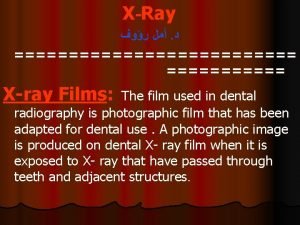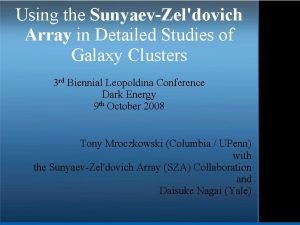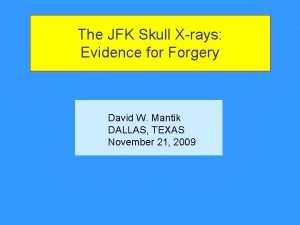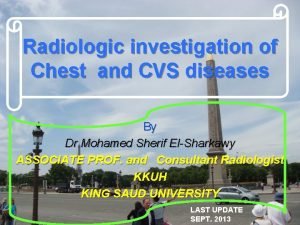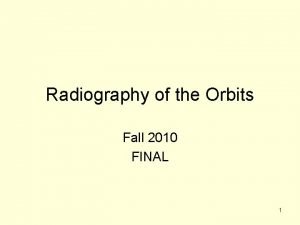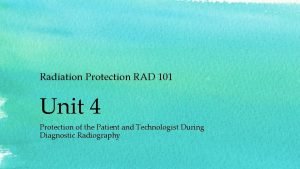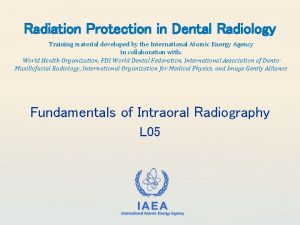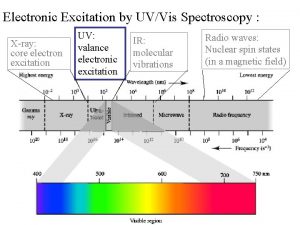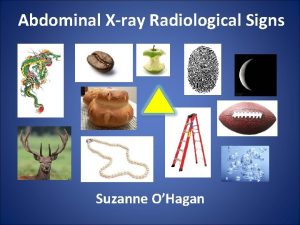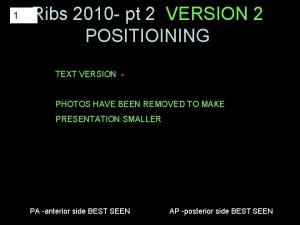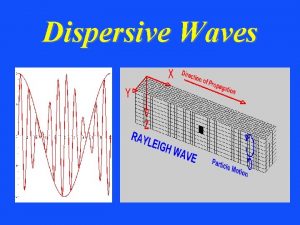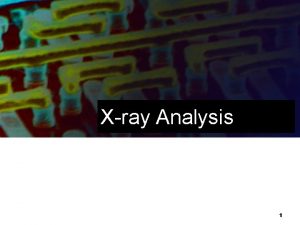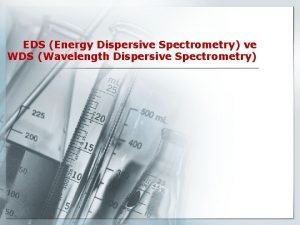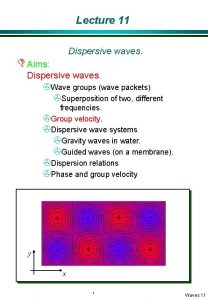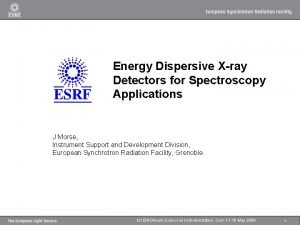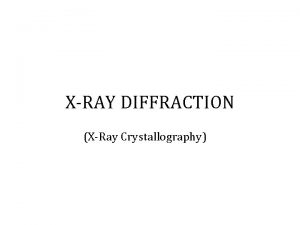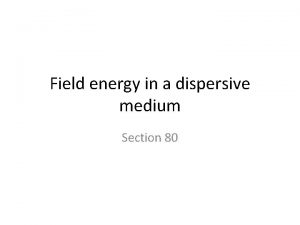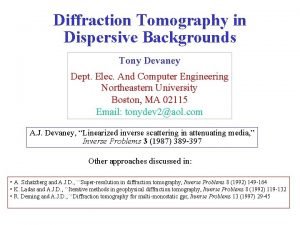Lets Familiarize Ourselves with the Energy Dispersive XRay
























- Slides: 24

Let’s Familiarize Ourselves with the Energy Dispersive XRay Spectroscopy Saeedeh Ghaffari Nanofabrication Fall 2011 February 21 1

Outline Introduction X-Ray Generation Analysis Detection Reference February 21 2

Introduction February 21 3

Introduction February 21 4

Introduction An analytical technique used for the elemental analysis or chemical characterization of a sample Relies on the investigation of an interaction of some source of X-ray excitation and a sample Determines characteristic of an atom due to the a unique atomic structure February 21 5

Types of X-ray Continuous x-rays background radiation must be subtracted for quantitative analysis Characteristic x-rays elemental identification quantitative analysis Example of Eds spectrum February 21 6

Continuous(Bremsstrahlung) The energy emitted as an x-ray when the electron incident on a specimen is bent on its trajectory Decelerated by the electrostatic field of a nucleus This x-ray does not have a value unique to an element This background is excluded for quantitative analysis February 21 7

Characteristic An incoming high-energy electron dislodges an inner-shell electron in the target, leaving a vacancy in the shell An outer shell electron then “jumps” to fill the vacancy A characteristic x-ray (equivalent to the energy change in the “jump”) is generated February 21 8

Characteristic • The difference in energy between two orbits has a unique value for each element, the energy of the emitted xray is also unique to the element February 21 A typical spectrum obtained on mineral particles of up to 2μm diameter. The peaks are labeled with the EDX line of the corresponding element 9

Pure Ge Several examples of EDS spectra Characteristic Al film on Si Pure Al February 21 Silica glass Graphite Organic 10

Electron Transition • A variety of characteristic energy Xrays is generated as the various displaced inner-shell electrons are replaced by the various outer-shell electrons February 21 11

Electron Transition February 21 12

Characteristic Typical characteristic x-ray and their names February 21 13

X-Ray Energies X ray Energies are a function of Z (atomic number) K lines: lighter elements L lines: heavier elements M, N. . lines: the heaviest elements Kα: Be (Z = 4) 110 e. V Fe (Z = 26) 6. 4 ke. V Au (Z = 79) 68. 8 ke. V Lα: Fe 0. 70 ke. V Au 9. 71 ke. V A threshold energy to eject electron increases with atomic number February 21 Note: The EDX detectors work well only in the range 1 -20 kev 14

X-Ray Analysis Qualitative Analysis: Peak energy gives qualitative information about the constituent elements Quantitative Analysis: Peak intensity gives information about the element composition to find the changes in concentration of elements • Note: The minimum detection limits vary from approximately 0. 1 to a few atom percent, depending on the element and the sample matrix. February 21 15

EDS Setup • Four primary components of the EDS setup: • Beam source • X-ray detector • Pulse processor • Analyzer February 21 16

EDX Detector • Crystal detects X-rays • Liquid nitrogen cools crystal to reduce noise and also pumps dewar • Window separates detector from column vacuum • Collimator eliminates stray x-rays February 21 17

EDX Detector • X-rays pass through : • collimator • electron trap • window • gold layer • dead layer into Li-drifted Si crystal (Si. Li) February 21 18

Solid State Detector in EDX February 21 19

Si(Li) Crystal Anti-reflective Al coating 30 nm Ice Gold electrode 20 nm Silicon inactive layer (p-type) ~100 nm X-ray Holes (+) (–) Window Be, BN, diamond, polymer 0. 1 mm — 7 mm Electrons Active silicon (intrinsic) 3 mm – 1000 V bias February 21 20

X-Ray Detection Electron - hole pairs created. Each electron-hole pair requires a mean energy of 3. 8 e. V Bias voltage sweeps charge carriers to either side Charge proportional to Xray energy Note: Charge is small! Noise is a potential problem. Note: High energy X-rays may not be dissipated in the active region of the crystal! Incomplete charge collection. (EDX spectrometers work best in the region 1 -20 Kev) February 21 21

X-Ray Processing 1. 2. 3. 4. 5. X-ray comes in, creates an e h pair Charge pulse enters FET, converted to voltage pulse Voltage pulse amplified several thousand times Analog-to to-digital converter used to assign pulse to specific energy Computer assigns x-ray as a ‘count’ in a multi-channel analyzer February 21 22

References Robert Edward Lee, Scanning electron microscopy and X-ray microanalysis, Prentice-Hall (1993) Goldstein book Wikipedia: energy dispersive Xray spectroscopic Let’s familiarize ourselves with the SEM booklet Microanalyst. net February 21 23

Thanks for your Concentration February 21 24
 Describe a normal healthy nail
Describe a normal healthy nail Familiarize with the process
Familiarize with the process Energy energy transfer and general energy analysis
Energy energy transfer and general energy analysis Energy energy transfer and general energy analysis
Energy energy transfer and general energy analysis X ray mastoid towns view
X ray mastoid towns view Purpose of lead foil sheet in the film packet
Purpose of lead foil sheet in the film packet Plain film kub
Plain film kub Xray xml editor
Xray xml editor Sza xray
Sza xray Jfk jr plane crash photos
Jfk jr plane crash photos Tetralogy of fallot xray
Tetralogy of fallot xray Causes of rickets
Causes of rickets Rib anatomy anterior
Rib anatomy anterior Rhese method x ray
Rhese method x ray Ombl radiography
Ombl radiography Xray technique chart
Xray technique chart Faulty radiographs
Faulty radiographs High frequency generator x ray
High frequency generator x ray Xray lara
Xray lara Subject contrast
Subject contrast Uv xray
Uv xray Tetralogy of fallot
Tetralogy of fallot Retroperitoneal fibrosis radiopaedia
Retroperitoneal fibrosis radiopaedia Noi toi poi doi
Noi toi poi doi Oblique ribs xray
Oblique ribs xray





